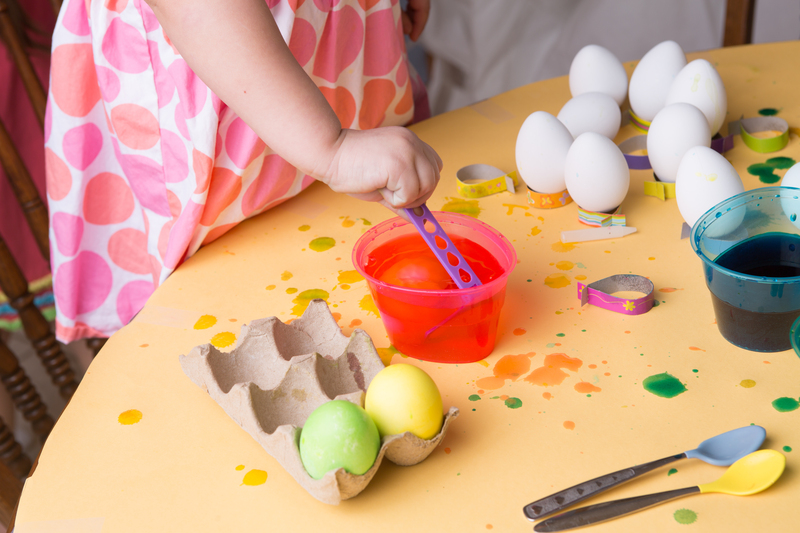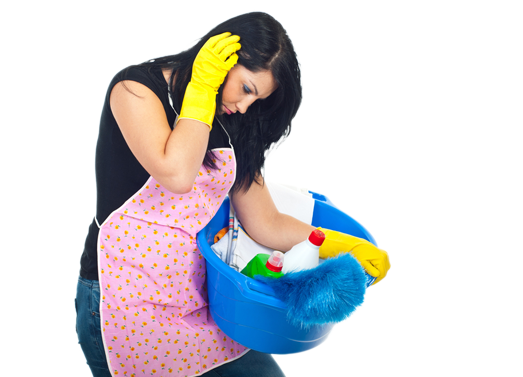Effective Strategies to Keep Your Bathroom Free from Mold
Posted on 02/09/2025
Effective Strategies to Keep Your Bathroom Free from Mold
A clean, healthy bathroom is essential for any home. One of the most persistent problems homeowners face is the growth of mold in bathrooms. Not only does mold mar your bathroom's appearance, but it can also trigger allergies, create unpleasant odors, and even damage structural elements over time. By practicing effective mold prevention strategies, you can keep your bathroom sparkling and healthy. This comprehensive guide will cover actionable steps, expert tips, and essential maintenance routines to help you maintain a mold-free bathroom environment.

Understanding Mold Growth in Bathrooms
Before diving into prevention, it's crucial to understand why bathrooms are particularly vulnerable to mold. Mold thrives in damp, humid, and poorly ventilated areas. Bathrooms often provide all three conditions, especially after steamy showers, overflowing bathtubs, or leaking faucets.
Humidity: Steamy showers and baths produce excess moisture in the air.Poor Ventilation: Insufficient air circulation lets moisture linger, increasing condensation on walls and ceilings.Water Intrusion: Leaky faucets, damp towels, and wet shower curtains provide mold with a continuous source of moisture.Organic Material: Soap scum, dust, and bathroom surfaces provide nutrients for mold spores to feed on and multiply.
To keep your bathroom free from mold, it's important to address each of these factors. Using a combination of cleaning, maintenance, and smart design, you can significantly reduce the risk.
1. Optimize Bathroom Ventilation
Install or Upgrade Exhaust Fans
Exhaust fans play a pivotal role in removing humid air from bathrooms. If your bathroom doesn't have a fan, install one as soon as possible. For existing fans, ensure they are properly sized for your bathroom and in good working order.
- Run the fan during showers and for at least 20 minutes after to clear residual moisture.
- If feasible, upgrade to a humidity-sensing fan that starts automatically when moisture rises.
- Clean the fan blades and housing regularly to ensure maximum efficiency.
Open Windows and Doors
Natural ventilation is another valuable way to prevent moisture build-up. Whenever possible:
- Crack open windows during and after showers.
- Leave the bathroom door ajar to facilitate air exchange between the bathroom and drier parts of your home.
2. Minimize Moisture Accumulation
Wipe Down Surfaces
After each use, use a squeegee or microfiber cloth to wipe down shower walls, glass doors, and tiles. Pay special attention to:
- Showers and Bathtubs: Remove excess water from tiles, grout, and fixtures to limit mold-friendly dampness.
- Sinks and Countertops: Dry up spills and puddles immediately to prevent seepage.
Control Bathroom Humidity Levels
Keep the overall humidity in check by using a hygrometer to monitor levels. Ideally, bathroom humidity should stay below 50%. If your bathroom is consistently humid:
- Consider installing a dehumidifier suitable for small spaces.
- Use moisture-absorbing products such as silica gel packs or reusable moisture absorbers in corners prone to dampness.
Fix Leaks Promptly
Persistent leaks are a frequent mold culprit. Inspect your bathroom regularly and take action immediately if you notice:
- Dripping faucets or showerheads.
- Pooled water under the sink or near the toilet base.
- Discoloration or soft spots in ceilings and walls adjacent to the bathroom.
Timely plumbing repairs are essential for keeping your bathroom mold-free and extending the life of fixtures.
3. Adopt a Consistent Bathroom Cleaning Routine
Use Mold-Resistant Cleaning Products
Regular cleaning discourages mold growth, especially when you use the right products. Seek out shower sprays, tile cleaners, and grout solutions specifically labeled as anti-mold or containing bleach, hydrogen peroxide, or vinegar.
- After each shower: Spray a daily shower cleaner to prevent soap scum and mildew buildup.
- Weekly: Deep-clean tile, grout, and all corners with a mold-inhibiting agent.
- Monthly: Check under sinks and behind toilets for hidden mold or moisture.
Don't Neglect Bathroom Accessories
Items like shower curtains, bath mats, loofahs, and towels can harbor mold if left damp for extended periods. To limit risks:
- Wash shower curtains and mats regularly, preferably with hot water and a splash of bleach.
- Hang towels and bathmats to dry after each use; avoid crumpling or leaving them on the floor.
- Replace loofahs and sponges every few months, as they can quickly become breeding grounds for bacteria and mold.
4. Upgrade to Mold-Resistant Fixtures and Materials
If you're remodeling or upgrading, invest in mold-resistant materials throughout your bathroom:
- Paint: Use bathroom-specific or mold-resistant paints for walls and ceilings.
- Tile and Grout: Choose epoxy grout over standard grout, as it is less porous and much more resistant to water infiltration.
- Showers and Bathtubs: Install acrylic, porcelain, or glass panels rather than porous natural stone.
- Flooring: Select non-porous tiles or waterproof vinyl instead of absorbent materials like untreated wood or carpet.
Investing in high-quality, mold-resistant products can dramatically reduce long-term maintenance needs and the risk of persistent mold issues.
5. Regularly Inspect for Early Signs of Mold
Early detection is key for effective mold control in bathrooms. At least once a month, carefully examine:
- Tile grout and caulking (especially in shower areas)
- Under sinks and behind toilets
- Bathroom windowsills and thresholds
- Ventilation fans and light fixtures
- Floor areas around tubs and toilets
Warning signs include dark spots, musty odors, discolored patches, and softened drywall. If you spot mold, clean it immediately using dedicated anti-mold cleaners or a solution of bleach and water (test on a small area first).
6. Practice Smart Ventilation Habits
- Shower with the bathroom door open when privacy allows
- Hang wet towels and bath mats outside the bathroom for quicker drying
- Store personal care products (like razors and toothbrushes) in dry, closed cabinets rather than directly in the shower area
7. Address Persistent Mold Issues Professionally
If you repeatedly notice mold in your bathroom despite following best practices, you may have a more significant problem:
- Water leaks behind walls, under floors, or above ceilings
- Inadequate bathroom exhaust systems or poor overall home ventilation
- Structural problems allowing water seepage from the exterior
In these cases, it is wise to consult a professional mold remediation specialist or licensed plumber to address underlying causes and perform thorough remediation.
Mold Prevention Tips for Every Bathroom
- Keep clutter to a minimum - more items mean more surfaces for condensation and mold growth.
- Seal grout lines annually to create a moisture barrier and protect against mold intrusion.
- Use water-resistant caulk around tubs, sinks, and windows and reapply as necessary.
- Let natural light in - UV rays can help neutralize mold spores.
- Choose glass shower doors instead of curtains, as they dry faster and are easier to clean.

Frequently Asked Questions (FAQs)
How often should I clean my bathroom to prevent mold?
For the best mold prevention in bathrooms, wipe down wet surfaces after every use, perform light cleaning weekly, and deep-clean with anti-mold products monthly.
Can plants in the bathroom help reduce mold?
Some houseplants can absorb moisture and improve air quality. However, too many or poorly maintained plants could increase humidity and provide additional organic material for mold. Choose moisture-loving, air-purifying varieties such as ferns or peace lilies and avoid overwatering.
What's the safest way to remove mold from bathroom surfaces?
Always wear gloves and a mask. Start with natural cleaners (vinegar or baking soda) for minor outbreaks. For stubborn mold, use commercially available anti-mold sprays or a diluted bleach solution (one cup of bleach per gallon of water), testing a small area first.
Are there specific paints to help keep bathrooms mold-free?
Yes! Use high-quality, mold-resistant or mildew-resistant paints formulated for bathrooms and high-moisture areas. These contain antimicrobial agents that limit mold colonization and are easy to clean.
Conclusion: Achieving a Mold-Free Bathroom
Keeping your bathroom mold-free isn't just about aesthetics; it's a crucial step for maintaining a healthy home environment. By combining effective ventilation, diligent cleaning, moisture control, and the use of mold-resistant materials, you set the stage for long-term success. Make these effective strategies for bathroom mold prevention part of your regular home care routine, and enjoy a fresh, clean, and inviting bathroom year-round.
If you stay vigilant and proactive, you can win the fight against mold and reclaim your bathroom as a safe, relaxing retreat.
- Stay proactive with inspections
- Clean regularly and choose anti-mold products
- Upgrade to mold-resistant fixtures where possible
- Address water leaks quickly
- Maintain good ventilation at all times
With these effective solutions for bathroom mold control, you and your family can breathe easy in a clean, healthy space, free from the threats of mold.





